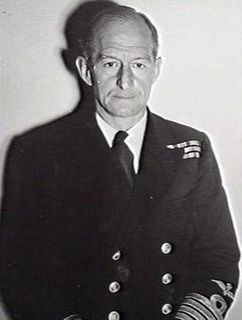
The Home Fleet was a fleet of the Royal Navy that operated in the United Kingdom's territorial waters from 1902 with intervals until 1967. Before the First World War, it consisted of the four Port Guard ships. During the First World War, it comprised some of the older ships of the Royal Navy. During the Second World War, it was the Royal Navy's main battle force in European waters.

The Fifth Sea Lord was formerly one of the Naval Lords and members of the Board of Admiralty that controlled the Royal Navy. The post's incumbent had responsibility for naval aviation.

The Deputy Chief of the Naval Staff (D.C.N.S.) is a senior appointment in the Royal Navy currently held by the Second Sea Lord, usually a three-star rank and had a NATO ranking code of OF-8 but has previously been held by an acting two-star ranked officer and a four-star ranked officer.

The Operations Division was a former Directorate of the Admiralty Naval Staff responsible for the creation and implementation of long-term policy in regards to the composition of all Royal Navy fleets, squadrons and commands and including operational planning and monitoring from 1912-1961.

The Anti-Submarine Division its original name, was the former anti-submarine warfare, planning and prevention Directorate of the Admiralty Department from 1912-1963.

The Plans Division was the former war preparation and wartime strategic planning arm of the Admiralty Department from 1917-1964, The division originally became the main policy advisory and formulating body to the Chief of the Naval Staff. It later came under the supervision of the Assistant-Chief of the Naval staff (Policy).

The Mobilisation Division was the former Directorate of the British Admiralty Naval Staff responsible for mobilisation requirements, manning and war preparation planning from 1912-1918.

The Gunnery and Torpedo Division was the former Directorate of the Admiralty Naval Staff responsible for weapons policy making, development and assessing weapon requirements from 1918-1920.

The Signal Division was a Directorate of the Admiralty Naval Staff responsible for policy, control and management of all naval communications from 1914 to 1964.

The Naval Ordnance Department, also known as the Department of the Director of Naval Ordnance, was a former department of the Admiralty responsible for the procurement of naval ordnance of the Royal Navy the department was managed by a Director supported by various assistants and deputy's it existed from 1866 to 1958.

The Trade Division was a Directorate of the British Admiralty, Naval Staff responsible for all matters in relation to U.K. Trade Defence from 1914 until 1928 and then again from 1939-1961.

The Gunnery Division was a Directorate of the Admiralty Naval Staff of the Royal Navy responsible for the tactical use of naval weapons and the training of naval personnel in relation to operational requirements. It was established in 1920 when the Gunnery and Torpedo Division was separated into an independent Gunnery Division and Torpedo Division it existed until 1964 when the Department of Admiralty was abolished and replaced by a new Ministry of Defence.

The Training and Staff Duties Division and later known as the Tactical and Staff Duties Division was a directorate of the Admiralty Naval Staff of the Royal Navy responsible for the tactical use of naval weapons and the training of naval personnel in relation to operational requirements from 1917 to 1958.

The Admiral Commanding, Reserves, (ACOMRES) was a senior Royal Navy post that existed from 1875 to 1976.

The Trade and Operations Division (T.O.D.) was a division of the Admiralty Naval Staff created in 1961 following the merger of two former naval staff divisions one for Trade and the other for Operations. The staff division was administered by the Director, Trade and Operations Division. It existed until 1967.

The Directorate of Navigation and Tactical Control (Naval) was a directorate of the Navy Department, Naval Staff first established in 1912 as the Navigation Department of Hydrographic Department of the Admiralty. In 1945 it was renamed the Navigation Division and assigned to the Admiralty Naval Staff. In 1946 it was re designated Navigation and Direction Division until 1966 and now part of the Navy Department Naval Staff it was renamed the Directorate of Navigation and Tactical Control (Naval). The staff directorate was administered by the Director Navigation Tactical Control (Naval) who reported to the Assistant Chief of the Naval Staff (Warfare) it existed until 1968.

The Directorate Naval Tactical and Weapons Policy originally called the Tactical Division was a directorate of the British Naval Staff, Ministry of Defence, formed in 1925 it operated until 1939 before being abolished. The division was revived in 1958 and existed until 1968. The naval staff directorate was administered by the Director, Directorate Naval Tactical and Weapons Policy.

The Torpedo Division originally called the Gunnery and Torpedo Division was a naval staff organisation of the British Admiralty Naval Staff established in 1920 when the functions of the Gunnery and Torpedo Division was divided up into separate functions. It existed until 1928 when the it was abosrbed into the Tactical Division.

The Department of the Director of Underwater Weapons Materials originally known as the Torpedo Department was a former department of the British Department of Admiralty from 1917 to 1958 when it became the Underwater Weapons Division of the Weapons Department.









